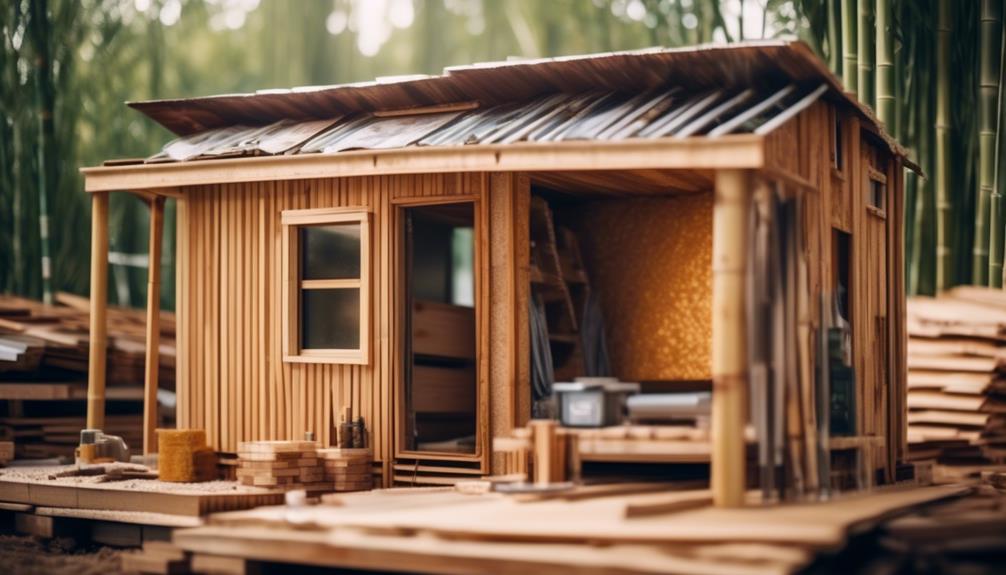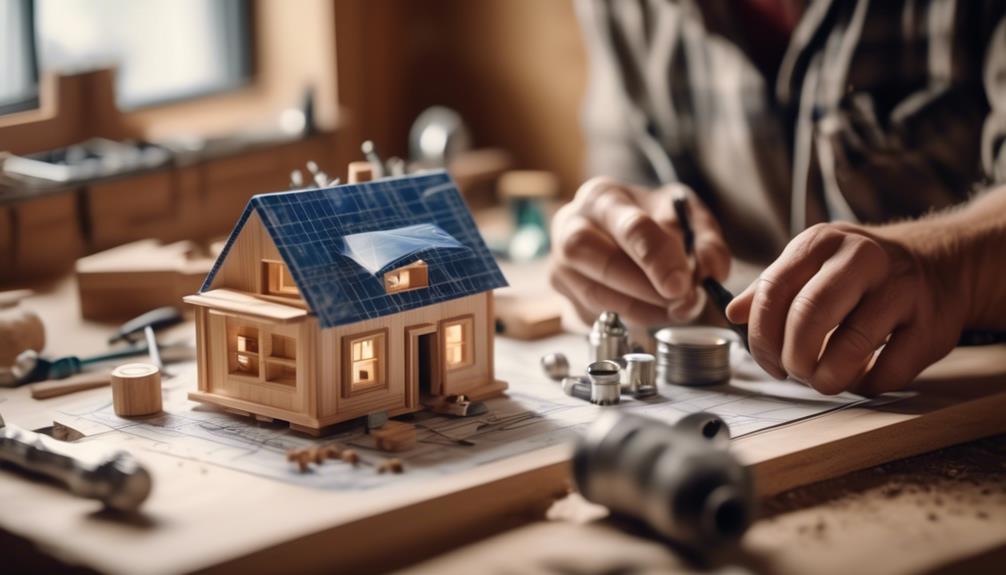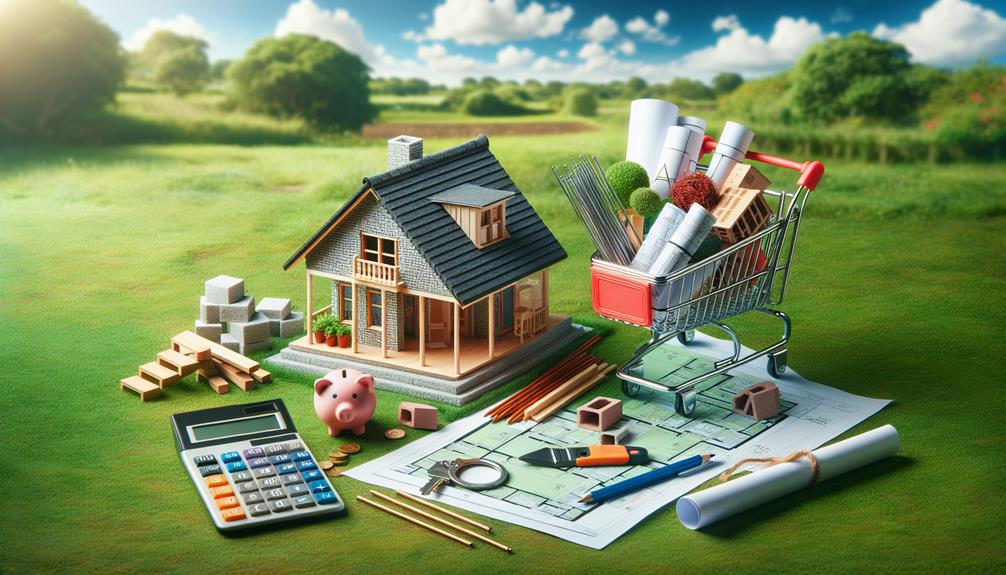They say a penny saved is a penny earned, and when it comes to building your tiny home, this couldn't be truer. You've dreamed of crafting a cozy, compact sanctuary, but as you stand on the precipice of construction, it's crucial to grip your finances as tightly as your dreams.
A well-thought-out budget isn't just a spreadsheet; it's the roadmap that steers your project from whimsical idea to delightful reality. As you navigate through cost estimates and material expenses, you'll need to weigh your desires against the hard numbers. Remember, the allure of tiny living is not just in its simplicity, but also in its affordability.
Stick with me as I guide you through pivotal budgeting strategies that ensure your tiny home doesn't morph into a massive financial burden, leaving you to ponder the fine balance between cutting costs and maintaining the integrity of your future abode.
Key Takeaways
- Assess your personal space requirements and lifestyle habits to determine the needs for your tiny home.
- Prioritize affordable and cost-effective building materials without compromising durability.
- Consider DIY construction to reduce labor costs and seek professional advice for legal and structural requirements.
- Ensure legal compliance with building codes and zoning regulations and explore alternative financing solutions for your tiny home build.
Assess Your Tiny Home Needs
Before diving into the design of your tiny home, it's crucial to evaluate your personal space requirements and lifestyle habits to ensure the final layout aligns with your day-to-day needs.
Analytically speaking, tiny house plans aren't one-size-fits-all; they require meticulous tailoring. Consider how many occupants will live there, their activities, and storage needs to ascertain the appropriate size and layout.
You must also assess your finances, as this will determine how much you can allocate for size and materials. Moreover, evaluate your electrical and water usage to ensure functionality.
Prioritize features that elevate comfort and convenience, always keeping in mind the principle to 'Budget and Stick'. This pragmatic approach is vital in creating a tiny home that's both innovative and sustainable.
Establish a Realistic Budget
Crafting your financial blueprint is the first step to ensuring your tiny home doesn't become a towering burden. Begin by determining the overall cost, factoring in the size of your home and the materials you'll use. Seek out high-quality materials that align with your budget, but don't cut corners where it'll hurt in the long run.
To create a realistic budget:
- Research financing options that can stretch your purchasing power.
- Calculate not just the cost of materials, but also the long-term savings they offer.
Strategically look for ways to save money, such as building from scratch or using structure shells. Your analytical approach will pay off, turning innovative living into a financially savvy venture, without compromising the integrity or functionality of your tiny home.
Choose Cost-Effective Building Materials

When choosing materials for your tiny home, you need to balance affordability with durability. Cheaper options might save money upfront but could lead to higher maintenance costs later. Sustainable materials, such as reclaimed lumber, not only cut costs but also minimize your environmental footprint, offering long-term value.
Analyzing each material's lifespan versus its cost is crucial. This evaluation ensures that you're making a prudent investment in your home's structural integrity and overall sustainability.
Selecting Affordable Materials
Selecting cost-effective building materials is crucial when budgeting for your tiny home, as it can significantly reduce overall expenses and enhance sustainability. Opt for a shell to ensure a professional-quality base at a fraction of the cost. Embrace DIY construction to eliminate labor costs, and install your own flooring and tiling to save even more.
- Using Reclaimed or Surplus Materials:
- Reclaimed windows add character and history
- Surplus lumber offers affordability without compromising quality
- Smart Building Techniques:
- Prioritize affordable materials that don't sacrifice durability
- Plan upgrades for the future to spread out expenses
Durability Versus Cost
Balancing the durability and cost-effectiveness of building materials is essential in constructing a tiny home that's both long-lasting and budget-friendly. When building a tiny house, proper planning helps you avoid costly mistakes. You'll want to choose materials that stand the test of time without breaking the bank. Consider not only the upfront cost but also the long-term maintenance expenses.
Here's an analytical look at materials, weighing durability versus cost:
| Material | Durability | Cost-Effectiveness |
|---|---|---|
| Steel | High | Moderate |
| Wood | Moderate | High |
| Vinyl | Low | High |
| Aluminum | High | Low |
| Composite | High | Moderate |
Prioritize materials that offer longevity and require minimal upkeep, ensuring your tiny house remains a sanctuary of innovation and practical design.
Sustainable Material Options
Embracing sustainability in your tiny home build not only protects the environment, but also ensures cost efficiency through the use of reclaimed or surplus materials. When selecting sustainable material options, you're not just building tiny homes; you're actively reducing your carbon footprint.
- Reclaimed or Surplus Materials
- Wood: Salvaged timber beams or flooring add character and history.
- Windows: Repurposed windows can be both affordable and eco-friendly.
Prioritize materials that offer longevity and energy savings, such as solar panels, which might have a higher upfront cost but provide long-term benefits. Be analytical in your approach:
- Energy-Efficient Additions
- Insulation: High-quality options keep heating and cooling costs down.
- Solar Panels: Reduce dependency on the grid and lower utility bills.
Consider DIY Construction Options

Exploring DIY construction for your tiny home can significantly reduce labor costs and imbue your project with a personal touch. Start by pricing out the necessary tools and materials to get an idea whether you need to lean more towards professional help or if getting some DIY experience is feasible.
Constructing your tiny house solo requires not just expertise, but access to machinery and space. If you possess construction skills, the DIY route offers great flexibility, allowing you to work at your own pace and save considerably. Remember to factor in how much it's likely to cost for both scenarios—fully DIY or a hybrid approach.
This detailed planning ensures your budget reflects the true cost of your hands-on involvement.
Seek Out Professional Advice
As you navigate the complexities of building your tiny home, consulting with industry experts can provide critical insights into the legal and structural requirements.
Engaging a financial planner will help you understand your financing options and craft a budget that aligns with your financial goals.
Ensuring legal compliance and obtaining practical cost estimates are imperative steps to mitigate potential risks and ensure the viability of your project.
Consulting Industry Experts
To ensure your tiny home project is built on a solid foundation of knowledge, it's critical to consult with industry experts who can provide expert insights and practical advice. These professionals are vital in:
- Navigating Complexities
- Understanding zoning laws and building regulations
- Obtaining the necessary permits
- Streamlining Your Build
- Accessing a network of trusted contractors and suppliers
- Identifying cost-effective solutions and materials
When building your tiny home, it's time to assess the full scope with those who know the industry best. They'll offer pragmatic strategies for financing help and Tips for Building Tiny, ensuring you understand how much it's likely to cost.
This level of detailed planning mitigates risks, saving you both time and money in the long run.
Financial Planning Assistance
Having consulted with industry experts to solidify your build's foundation, you'll next want to consider the financial scaffolding of your tiny home project by seeking professional financial planning assistance.
A financial planner or advisor can tailor a plan specifically for your tiny house, ensuring that you can afford the dream without compromising financial stability. They'll offer insights into managing costs effectively while exploring innovative financing options.
Legal Compliance Insights
When planning your tiny home build, it's crucial to seek professional legal advice to ensure compliance with all relevant building codes and zoning regulations. Legal compliance insights from experts can be the bedrock of your project, safeguarding against future complications.
Professional Advice:
- Lawyers with tiny house expertise
- Construction specialists
Their guidance will illuminate:
- Required permits
- Zoning intricacies
- Building standards
Securing legal advice isn't just about dotting the i's and crossing the t's; it's a strategic move to navigate the complexities of construction law. While it's likely to cost upfront, investing in professional counsel can save you from costly legal missteps and contribute to a solid foundation for your innovative tiny home build.
Explore Alternative Financing Solutions
Exploring alternative financing solutions can provide the necessary funds for your tiny home build without traditional mortgage constraints. When you're determining whether you can afford to build a tiny house, consider grants or assistance programs; these can be a lifeline for the down-payment.
Personal or unsecured loans are a great option, offering flexibility without requiring collateral. To be analytical, you must compare interest rates and terms meticulously, ensuring you choose the most cost-effective solution.
Additionally, seeking out affordable building suppliers will stretch your budget further. Accessing financing through credible lenders specializing in manufactured homes will align with your tiny house dreams, as they understand the unique nature of your project.
Always remember, the right financing strategy is crucial for a successful tiny home build.
Frequently Asked Questions
How to Budget for Building a Tiny Home?
To budget for a tiny home, prioritize design simplicity and DIY potential. Choose materials wisely, watch for hidden costs, and explore diverse financing options to ensure your build's financially feasible and innovative.
Is It Cheaper to Buy or Build a Tiny House?
Building a tiny house often costs less than buying pre-built, considering DIY savings, material selection, and customization costs. However, pre-built advantages include speed and adherence to tiny house trends without immediate labor.
Do Tiny Homes Actually Save Money?
Yes, tiny homes save money through sustainability benefits, lower property taxes, and by encouraging a minimalist living and downsizing strategy. However, the community impact varies and must be analyzed pragmatically for long-term savings.
How to Build a Small House on a Budget?
To construct an affordable tiny house, focus on design simplicity and material sourcing. You'll save by embracing DIY construction, optimizing space, and considering off-grid options, paving the way for innovative, cost-effective living.
Conclusion
In closing, your tiny home dream hinges on a careful balance of desires and dollars. By meticulously assessing needs, setting a realistic budget, and choosing cost-effective materials, you're paving a path to success.
Remember, the art of building small doesn't mean thinking small; it's about making every penny—and every square foot—count. Seek expert advice, weigh DIY against professional costs, and explore innovative financing.
Your tiny home awaits; let prudence be your guide and creativity your companion.

